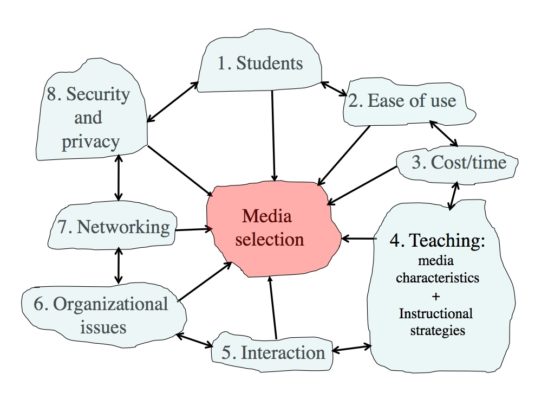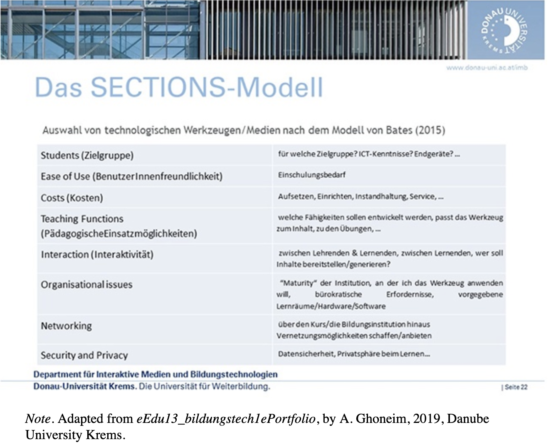
Keshavarz, M. and Ghoneim, A. (2021) Preparing Educators to Teach in a Digital Age. The International Review of Research in Open and Distributed Learning, Vol. 22, No.1, pp. 221-242.
This article describes how parts of my open, online textbook, ‘Teaching in a Digital Age‘ have been used for faculty development, in one case in Iran, and in another, in Austria.
Who are the authors?
Professor Mohsen Keshavarz is Director of the Virtual Education Center of Torbat Heydariyeh University of Medical Sciences in Razavi Khorasan Province, Iran.
Dr. Andrea Ghoneim is currently on the staff of Digital Teaching Services at Vienna University of Economics and Business, Wirtschafts Universität, Austria.
I provide a brief version of the paper below. If you are interested you should read the original paper. Most of what follows are direct quotes from the paper
What is the article about?
The article describes the practical implementation of parts of Teaching in a Digital Age: Guidelines for Designing Teaching and Learning in a course for educators in Austria and the development of medical education for universities in Iran. The authors show the impact of the book in training educators and developers of educational content.
How was the book used?
Different parts of the book were used in different ways in the two participating institutions:
Austria
Part of Teaching in a Digital Age, Chapter 9 (v.2) on media selection, was used in one of the modules, eEducation12 (6 ECTS – – European credits) for a Master’s program (90 ECTS) in e-Education at Danube University Krems, Austria.
In the module, students studied learning theories and wrote a short paper on a media-supported learning scenario. Pages were set-up on the course’s Wiki, with the topics of the students’ papers. The SECTIONS model’s criteria for media selection were presented to students in German.

Following the introduction of the model criteria, students worked in pairs to complete an assignment, using the model:
- Interview your peer: Ask them about the tool/medium they presented in their paper. Consider how you would evaluate their tool using the SECTIONS model.
- Write an entry about the tool in the course Wiki and discuss the learning theories that correspond with the use of the tool.
The instructor suggested that students with similar paper topics form pairs. Each pair was responsible for editing two Wiki pages (about two media).
The students found the SECTIONS model criteria very useful not only in completing the assignment but also in their professional work. Some students had read parts of Teaching in a Digital Age before the presentation on the SECTIONS model and the assignment. Furthermore, some of the students’ e-portfolios for the course showed that they had read more of the book to complete their assignments on the use of educational technology.
Iran
One main goal of the Virtual Education Center of Torbat Heydariyeh University of Medical Sciences is to lead and establish virtual education standards and create a scientific hub of e-learning in eastern Iran. Setting standards for e-learning centers and schools among medical sciences universities across Iran is also the responsibility of the Virtual University of Medical Sciences (VUMS). However, another main goal of VUMS is to develop virtual medical education programs and create innovative national projects
To accomplish these goals, educational policymakers at the Virtual University of Medical Sciences undertook the establishment of a national MOOC platform, ARMAN MOOCs. (ARMAN is a Farsi abbreviation for New and Massive National Computerized Education). ARMAN MOOCs are the only national MOOCs in Iran in the field of medical sciences. One of the main tasks of the Virtual University of Medical Sciences is to produce e-content for the national MOOCs, with the help of medical sciences universities across Iran.
Before setting up the Virtual Education Center in 2018, faculty members of Torbat Heydariyeh University of Medical Sciences mainly used traditional teaching methods and were not familiar with virtual teaching.
To implement educational technology at the university, the Virtual Education Center…designed several workshops to familiarize faculty members with the concepts of modern educational technology. These workshops were held at Mashhad University of Medical Sciences and were organised by Professor Keshavarz. Professor Kershavarz had previously facilitated the translation of parts of Teaching in a Digital Age (version 1) into Farsi (Persian). A Farsi translation of the second edition will be completed by the end of 2021.
Before one of the workshops, participants completed a multiple-choice questionnaire to assess their knowledge about MOOCs. Results of the questionnaire revealed that the faculty members had very little knowledge in this area.
One workshop began with a presentation of a video that I had specially prepared to establish the international character of the workshop. The workshop instructor then introduced the concept, history, and types of MOOCs based on Chapter 5 of Teaching in a Digital Age (version 1) as well as examples and models from the book. For many faculty members, this was their first encounter with MOOCs. The Farsi translation of Teaching in a Digital Age was also introduced. Participating faculty members reported that they were very satisfied with the workshop.
A second workshop, “Introduction to MOOCs,” was held at Mashhad University of Medical Science on February 13, 2019. The fourth part of this workshop, which also covered the concept of MOOCs, focused on introducing the MOOCs concept, using the book Teaching in a Digital Age.
In October 2019, the Virtual Education Center at Torbat Heydariyeh University of Medical Sciences and faculty from diverse health fields at the university produced 34 items of electronic content for the national ARMAN MOOCs (Virtual University of Medical Sciences, 2018). These e-contents are now available to all medical students and students interested in health issues on the ARMAN MOOC Website. The ARMAN MOOCs are in Farsi, but its platform managers aim to develop the MOOC nationally and internationally.
Another workshop, Introduction on MOOCs, was held on September 25, 2019, at Bojnurd University of Medical Sciences in North Khorasan Province for faculty members and university administrators. Faculty members of Torbat Heydariyeh of Medical Sciences were also invited to this workshop. The content for this workshop was primarily drawn from Teaching in Digital Age. In addition to providing an introduction to MOOCs, the workshop instructor advised administrators on the development of virtual education infrastructure. As a result of the workshop, Bojnurd University of Medical Sciences administrators are in the process of setting up a professional studio for audio and video recording and intend to produce electronic content for the ARMAN MOOC.
Torbat Heydariyeh University has expanded the use of virtual education among its faculty members by familiarizing them with MOOCs and e-learning methods, using Teaching in a Digital Age in workshops and personal consultations. In their paper, the authors argue that the use of the book at the university and regional level has contributed (among other things) to:
- the introduction of new educational technology, such as MOOCs, virtual reality, augmented reality, and gamification to faculty members; and the presentation of workshops about e-learning at other large medical sciences universities in Iran;
- an increase in faculty members’ motivation, interest, and flexibility in using new teaching methods, both virtual and hybrid, in their courses, and an increase in student access to faculty content, and creating a dynamic movement in the universities of the region to establish e-learning standards.
- the production of mass electronic content in the field of medical sciences by faculty members, and the generation of income from sales of virtual education products.
- establishment of a Virtual Education Center under the standards of the Virtual University of Medical Sciences of the Ministry of Health.
Authors’ conclusion
The use of Teaching in a Digital Age in workshops and personal consultations at an Iranian university and in a blended-learning course at an Austrian university has inspired faculty members and students to broaden and deepen their knowledge about educational technology, the production of content for technology-supported learning via MOOCs, and media-supported teaching and learning.
My comments
The book has been downloaded at least 500,000 times (I’ve now lost track since last year), and translated into ten languages, so it must be reasonably popular. Nevertheless I really don’t know how the book is being used, and it is difficult to know, even after reviews in journals such as MERLOT’s Teacher Education, how useful people are finding it.
Although I have been collaborating with Professor Kershavarz for a number of years, I was therefore both surprised and pleased to see the article in IRRODL. I was completely unaware of the use of the book at the Danube University Krems. I was particularly struck by a quote in this article from Serpil Kocdar at the Anadolu University in Turkey. He wrote, in his review of the book for IRRODL (2017):
“It combines theoretical and conceptual knowledge with practical information by presenting scenarios from real-life experiences, reflective questions in the activities, podcasts, videos, and the author’s observations. I felt a continuous interaction with the author while reading the book.”
I hope many other readers feel a continuous interaction with me. An author can ask no more of their work.
Reference
Kocdar, S. (2017). Designing Teaching and Learning for a Digital Age. The International Review of Research in Open and Distributed Learning, Vol.18, No.3









 Dr. Tony Bates is the author of eleven books in the field of online learning and distance education. He has provided consulting services specializing in training in the planning and management of online learning and distance education, working with over 40 organizations in 25 countries. Tony is a Research Associate with Contact North | Contact Nord, Ontario’s Distance Education & Training Network.
Dr. Tony Bates is the author of eleven books in the field of online learning and distance education. He has provided consulting services specializing in training in the planning and management of online learning and distance education, working with over 40 organizations in 25 countries. Tony is a Research Associate with Contact North | Contact Nord, Ontario’s Distance Education & Training Network.


Teaching in digital age is an excellent book.